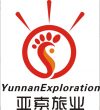
Jinjiang Town of Shangri-La City, Diqing
Geography
Jinjiang Town (金江镇) is located in the southwestern part of Shangri-La City (香格里拉市), at 99°39′–100°01′ east longitude and 26°52′–27°21′ north latitude. The town government is seated in Wuzhu Kaikun Village (吾竹开文村), with an elevation of 1,900 meters. It is 188 kilometers away from the Shangri-La county seat. To the east, it borders Hukou Township (虎跳峡镇) along a mountain ridge, and to the west, it faces Yulong Naxi Autonomous County (玉龙纳西族自治县) across the river.
Ethnic Groups and Traditional Skills
Jinjiang Town is a multi-ethnic area, home to Han, Tibetan, Naxi, Bai, Miao, Lisu, Yi, Pumi, and other ethnic groups. These ethnic groups have continuously interacted and integrated over the course of history, creating a unique cultural character. In terms of traditional skills, the Dongba script and painting of the Naxi people, the Thangka painting and Tibetan weaving of the Tibetans, and the wood carving of the Bai people all hold significant positions in the local cultural heritage.
Customs and Festivals
The various ethnic groups in Jinjiang Town have preserved many traditional customs and festivals. For example, the Naxi people celebrate the “San Duo Festival” (三多节), the Tibetans observe the Tibetan New Year, and the Bai people hold the “March Street” (三月街). During the Spring Festival, people from different ethnic groups celebrate together, visiting each other and exchanging New Year greetings, sharing the joy of the festival. Additionally, in Xinglong Village (兴隆村), there is the custom of “grabbing the first water.” On New Year’s Eve, after staying up late to see the new year in, households immediately set off firecrackers at midnight and then rush to get the first water, symbolizing good fortune for the coming year.
Historical Architecture
Jinjiang Town is rich in historical relics, including traditional ethnic dwellings and religious buildings. These ancient structures not only hold significant historical value but also serve as important windows for visitors to understand the local history and culture.
Historical Figures
With a long history, Jinjiang Town has been an important node in various historical periods. It was once an important area of the “Huama Kingdom” (花马国). Since the middle of the Qing Dynasty in the second year of Emperor Yongzheng’s reign (1724), when Zhongdian (中甸) was incorporated into Yunnan, it became part of the border region.
Tourist Attractions
First Bend of the Yangtze River (长江第一湾): Jinjiang Town is home to the world-famous First Bend of the Yangtze River. Here, the river flows gently, creating a spectacular view.
Wuzhu Village (吾竹村): Wuzhu Village is a picturesque village with unique ethnic culture and natural scenery.
Red Cultural Sites: Jinjiang Town has deeply explored its cultural tourism resources and, in combination with red tourism education activities, has developed a red tourism route from Gaoshanlang Village (高山朗村) to Tangbei Village (塘北村). Visitors can retrace the revolutionary path and relive revolutionary history.
Transportation
Road: Jinjiang Town is conveniently accessible by road, with several provincial and county roads running through the area. It takes about three hours to drive from the Shangri-La county seat to Jinjiang Town.
Railway: There is currently no train station near Jinjiang Town. Visitors can first arrive in Shangri-La City and then transfer to a bus.
Air: Shangri-La Deqen Shangri-La Airport (香格里拉迪庆香格里拉机场) is approximately 188 kilometers away from Jinjiang Town and has flights connecting to cities such as Kunming and Chengdu.
Jinjiang Town, with its unique natural scenery, rich ethnic culture, and convenient transportation, is a destination worth visiting.

 7 Days GolfingTour
7 Days GolfingTour
 8 Days Group Tour
8 Days Group Tour
 8 Days Yunnan Tour
8 Days Yunnan Tour
 7 Days Shangri La Hiking
7 Days Shangri La Hiking
 11 Days Yunnan Tour
11 Days Yunnan Tour
 6 Days Yuanyang Terraces
6 Days Yuanyang Terraces
 11 Days Yunnan Tour
11 Days Yunnan Tour
 8 Days South Yunnan
8 Days South Yunnan
 7 Days Tea Tour
7 Days Tea Tour
 8 Days Muslim Tour
8 Days Muslim Tour
 12 Days Self-Driving
12 Days Self-Driving
 4 Days Haba Climbing
4 Days Haba Climbing
 Tiger Leaping Gorge
Tiger Leaping Gorge
 Stone Forest
Stone Forest
 Yunnan-Tibet
Yunnan-Tibet
 Hani Rice Terraces
Hani Rice Terraces
 Kunming
Kunming
 Lijiang
Lijiang
 Shangri-la
Shangri-la
 Dali
Dali
 XishuangBanna
XishuangBanna
 Honghe
Honghe
 Kunming
Kunming
 Lijiang
Lijiang
 Shangri-la
Shangri-la
 Yuanyang Rice Terraces
Yuanyang Rice Terraces
 Nujiang
Nujiang
 XishuangBanna
XishuangBanna
 Spring City Golf
Spring City Golf
 Snow Mountain Golf
Snow Mountain Golf
 Stone Mountain Golf
Stone Mountain Golf












